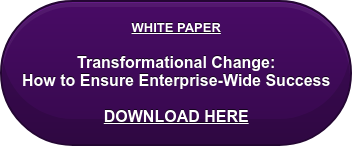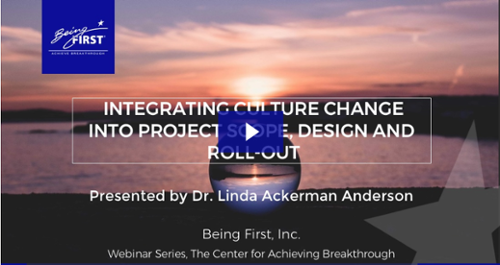Do you have too much change happening in your organization? Is there too little meaningful oversight and capacity to handle it all well? Are your leaders living in their own siloed worlds and failing to consider the broader organizational repercussions of their change projects? Do you wish you had a sane way to get on top of it all and align your leaders to do what is best for the organization as a whole?
Now you have a way: the Enterprise Change Agenda. This is the most important change leadership system and process you can build into your organization at the top. With all the change happening in organizations today the Enterprise Change Agenda gives CEOs a clear and organized mechanism to get their arms around it all and lead it effectively. It is a key strategy for ensuring the organizational alignment of change.
The Enterprise Change Agenda
An Enterprise Change Agenda names the most important change initiatives required to execute your organization’s business strategy. Its purpose is to identify, help launch, coordinate, and monitor the major changes underway or planned in your organization. It ensures their strategic relevance to business strategy and establishes the requisite conditions for their success. Its allows you to focus on mission-critical changes for the enterprise and its primary businesses. It may or may not include less significant changes underway or planned, depending on your capacity to accomplish and monitor them. This strategic overview enables you to be disciplined in what gets unleashed.
You are likely familiar with portfolio management—a method for collectively managing a group of current or proposed projects. While similar in concept, the Enterprise Change Agenda is owned by the senior executives and is designed to address the organization’s strategic initiatives. Its focus remains high-level— appropriate to executive oversight while the specifics of project goals, timelines, resource requirements, risks, and interdependencies can be handled by a portfolio management office or a strategic change office, project leadership teams, and other mechanisms within your organization’s change infrastructure. If you have a portfolio management office that serves the executives, tailor the Enterprise Change Agenda as an umbrella guidance system for it.
In most organizations, the decision to establish the discipline of an Enterprise Change Agenda belongs to the senior executive team. It can counteract the pervasive chaos, “project of the month,” competition, and costly capacity issues that leaders inadvertently create by initiating untold numbers of changes and pet projects. The agenda ensures that change does not get out of control and gives you greater strategic oversight and accountability for priority changes. It also helps you weave a cohesive story to communicate to your stakeholders and the workforce about where all the change activity is leading and the outcomes you intend it to produce.
Five Critical Success Requirements During Change
The Enterprise Change Agenda assists your organization and executives to ensure five critical success requirements:
- The change efforts you initiate in your organization are consistently the right ones to fulfill your business strategy. Identifying all efforts enables you to stand back and assess priorities against both your business strategy and your resources.
- Your change initiatives are consistently prioritized, organized, assigned, and paced in the optimal way. Each change effort is a building block ensuring your organization’s overall business strategy execution. Looking objectively at the whole picture reveals to you and your leaders if the picture is realistic, complete, and possible within an assumed timeframe. It also allows you to see where there may be conflicts, overlaps, interdependencies, holes, or opportunities for integration and coordination.
- The organization consistently has the capacity to carry out—and succeed—in its critical change efforts. Defining your entire change agenda while considering your full operational workload is the only way to realistically assess your organization’s true capacity for change. If your operations are at 100% capacity, then you must stop, delay, or modify current deliverables, or add resources to handle the requirements of your change efforts. Remember, any capacity needed for change must either be “borrowed” from existing operational capacity or added from outside the organization. You can’t ignore or override a lack of capacity without risking failure or burnout.
- You consistently maximize the best use of your external consultants in support of your change agenda. Your change agenda enables you to have an enterprise perspective on the use of these expensive resources, and supports leveraging them, coordinating them, and ensuring you have all your needs covered to produce your outcomes in the most cost-effective and timely ways, without duplication, loss of strategic oversight, or excessive expenditures.
- Your change efforts are aligned to collectively support your desired culture. Most if not all change initiatives on your agenda will have an impact on the organization’s culture and be affected by the prevailing leadership styles, work norms, mindsets, and leaders either “walking the talk” of your changes or not. Coordinated, overt attention to changing culture and realigning leadership styles in each effort is essential to producing and sustaining overall culture change and collective tangible results. It will not surprise you to know that culture change is the “glue” that sustains your changes over time.
How to Create Your Enterprise Change Agenda
To build your organization’s change agenda, start by identifying and grouping current or future change initiatives into four categories:
◗ Strategic importance to business success
◗ Enterprise-wide impact
◗ Functional or business-line specific
◗ Operational requirement
To populate your enterprise agenda, first identify the change efforts in each category, then cluster them to assist with prioritization. Ensure you and your executives are clear about your prioritization and selection criteria. Once an initiative receives your team’s “green light,” review your available resources and contracted services, and then ascertain if you have adequate capacity for all change efforts within each level. Lastly, map the initiatives in sequence, integrate where possible, and consider the impact on each effort’s stakeholders before you proceed with action. We call this part of the process “air traffic control”!
When to Create Your Enterprise Change Agenda
The creation of the Enterprise Change Agenda typically follows the organization’s strategic planning process and precedes your financial and operational planning cycles. Because new change efforts may arise in any of the sorting categories throughout the year, revisit the agenda periodically to ensure it is still relevant and accurate, and you have the capacity and resources to succeed in everything on it. One of your executives, or a Program or Strategic Change Office leader, can oversee the agenda and coordinate its use and accuracy throughout the year.
Organizations that have large autonomous business units should have each business create and monitor its own change agenda, aligned with enterprise requirements. This makes reporting on each business unit’s annual change priorities, progress, and resource usage very easy. These issues can and should be added to your status reporting scorecard.
The time invested in designing, gaining alignment, and embedding your Enterprise Change Agenda strategy and system will be well worth it in savings of speed, resource optimization, prioritization of work, and workforce relief. Demonstrating that you are on top of the huge magnitude of change work required for business success will gain you appreciation and much greater leadership credibility.



